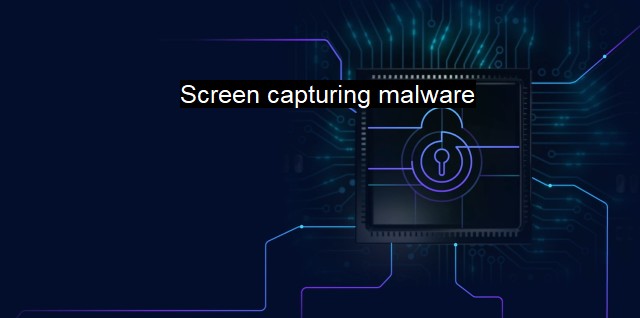What is Screen capturing malware?
Understanding Screen Capturing Malware and the Importance of Cybersecurity Solutions like Antivirus Software in the Modern Age
Screen capturing malware is a form of nefarious software that typically aims at stealing sensitive information from victims' devices, particularly by gaining unauthorized access to the data displayed on their screens. This type of malware is deemed remarkably dangerous due to the extensive harm it can cause; it not only invades privacy but poses significant risks to personal and corporate level cybersecurity, threatening to exude huge financial losses and sully reputations.The basic function of screen capturing malware is to capture whatever is displayed on the computer screen. By using keyloggers' underlying technology, such malware records every keystroke and mouse movement, enhancing its data theft capabilities beyond just textual input. Unlike traditional keystroke capturing, where the malware can only record the information input through the keyboard, screen capturing malware records the complete visual presentation. The captured data could include everything from login data, identities, financial and personal details, to equally substantial work-related confidential information.
Screen capturing malware can operate in a few different ways. First, it can execute time-framed screen capturing where the malware captures the screen at periodic intervals. Secondly, it can use event-triggered screen captures, snapping a screenshot whenever a specific application is opened or a certain website visited. Accessing and recording live streaming data, like video conferencing or online transactions is another potent methodology screen capturing malware employs, making it a formidable threat in the current digital landscape where such activities are rampant.
With the rapid growth of the digitalized world, screen-capturing malware has risen in prevalence and sophistication. It often sneaks into systems through phishing emails, misleading websites and fraudulent software or updates. Once the system gets infected, the malware lingers in the background with the user typically oblivious of its lethal presence. Even uncommon applications like smartphones, tablets and smart TVs are not immune to the threat since screen capturing malware is flexible to evolve and adapt to diverse platforms.
Given the seriousness of these threats, rigorous antivirus strategies and robust cybersecurity measures are warranted to mitigate the risks associated with screen capturing malware. Antivirus software plays the most crucial role here by constantly checking for known malware signatures and monitoring unusual activity that might signify the existence of new, unidentified malware. Heuristic scanning, a characteristic feature of modern antivirus software, has proved effective at detecting unknown malware threats by assessing potential hazards instead of relying solely on known malware information.
Cybersecurity is not limited to antivirus software but extends to safe practices like strong password protocols, two-factor authentication and encryption methods. Keeping system software up-to-date is paramount as it ensures all known vulnerabilities are patched. Implementing firewalls and intrusion detection/prevention systems add additional layers of security.
Raising awareness about cyber threats, including screen capturing malware, is the first step toward setting up a sturdy and successful defense. Employees or individual users must be educated about the perils of clicking on untrusted links, visiting unsolicited websites, or downloading questionable material.
Screen capturing malware is a potent cybersecurity threat that necessitates vigilant measures and practices. It operates covertly to capture and stealthily transmit data back to the perpetrators. Given its broad array of targets and the damage it can cause, having rigorous cybersecurity protocols, robust antivirus solutions, and safer digital habits can provide a solid bulwark against the threats posed by screen capturing malware. As the saying goes, prevention is certainly better than cure particularly in the context of cybersecurity.

Screen capturing malware FAQs
What is screen capturing malware?
Screen capturing malware is a type of malware that is designed to capture screenshots or record videos of a user's activity on their device. It is a serious cybersecurity threat that can compromise sensitive information such as passwords, credit card numbers, and other personal data.How does screen capturing malware infect a device?
Screen capturing malware can infect a device through various methods such as email attachments, fake software updates, malicious websites, or by exploiting vulnerabilities in the device's operating system. It is important to have updated antivirus software and to be cautious when downloading and installing software or clicking on links.What are the consequences of a device infected with screen capturing malware?
A device infected with screen capturing malware can result in the theft of sensitive information such as login credentials, banking information, and other personal data. It can also be used to monitor a user's online activity or to download additional malware onto the infected device.How can I protect my device from screen capturing malware?
To protect your device from screen capturing malware, you should regularly update your antivirus software, avoid downloading and installing software from untrusted sources, be cautious when clicking on links, and use strong and unique passwords for all accounts. It is also recommended to use a virtual private network (VPN) when accessing sensitive information online.| | A | | | B | | | C | | | D | | | E | | | F | | | G | | | H | | | I | | | J | | | K | | | L | | | M | |
| | N | | | O | | | P | | | Q | | | R | | | S | | | T | | | U | | | V | | | W | | | X | | | Y | | | Z | |
| | 1 | | | 2 | | | 3 | | | 4 | | | 7 | | | 8 | | |||||||